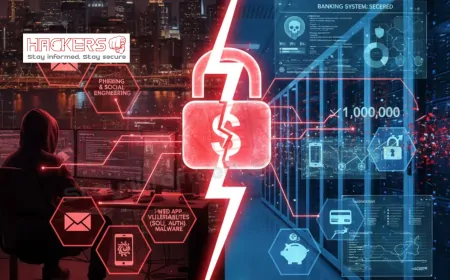Why Are Indian Banks Facing Increasing Data Breaches?
Imagine waking up to a notification that your bank account details have been stolen. Your hard-earned money, personal information, and trust in the banking system are suddenly at risk. This is not a scene from a thriller movie. It is a growing reality for millions of Indians. In recent years, data breaches in Indian banks have surged, leaving customers worried and institutions scrambling for answers. But why is this happening? Is it just bad luck, or are there deeper issues at play? In this blog, we will explore the reasons behind the rising number of data breaches in Indian banks. We will break it down in simple terms so that everyone, from tech-savvy readers to complete beginners, can understand the problem and what can be done about it.
Table of Contents
- Introduction
- The Rise of Data Breaches in Indian Banks
- Major Data Breach Incidents in Recent Years
- Key Reasons Behind the Breaches
- Impact on Customers and Banks
- What Can Be Done: Solutions and Prevention
- Conclusion
- Frequently Asked Questions
The Rise of Data Breaches in Indian Banks
Data breaches happen when unauthorized people gain access to sensitive information, such as customer names, account numbers, passwords, or transaction details. In India, the banking sector has seen a sharp increase in such incidents. According to reports from the Reserve Bank of India (RBI) and cybersecurity firms, the number of reported breaches has grown by over 50 percent in the last five years. This is alarming because banking is built on trust. When that trust is broken, it affects not just individual customers but the entire financial system.
The shift to digital banking has made things worse. More people are using mobile apps, online banking, and UPI (Unified Payments Interface) for daily transactions. While this brings convenience, it also opens new doors for cybercriminals. India now has over 800 million internet users, and banks are handling massive amounts of data every second. This digital explosion has made banks a prime target for hackers.
Major Data Breach Incidents in Recent Years
To understand the scale of the problem, let us look at some real examples. These incidents show how breaches can happen in even the biggest banks.
| Year | Bank/Institution | Details of Breach | Customers Affected |
|---|---|---|---|
| 2016 | Multiple Banks (Debit Card Breach) | Hackers compromised ATM networks via malware in a third-party payment switch. | Over 3.2 million |
| 2018 | State Bank of India (SBI) | Server vulnerability exposed customer data through an unsecured server. | Approximately 10,000 |
| 2021 | MobiKwik | Alleged breach of 99 million users' data, including phone numbers and emails. | Up to 99 million |
| 2022 | Air India (SITA Breach) | Third-party vendor breach affected passenger data linked to bank cards. | Over 4.5 million |
| 2023 | ICICI Bank | Phishing attacks led to unauthorized access to customer accounts. | Thousands |
| 2024 | HDFC Bank | Data leak of loan applicants' personal and financial information, including account numbers and transaction records. | Tens of millions |
These are just a few examples. Many smaller breaches go unreported or are not made public to avoid damage to reputation. But the trend is clear: breaches are becoming more frequent and larger in scale.
Key Reasons Behind the Breaches
Now, let us dive into the main reasons why Indian banks are facing so many data breaches. We will break them down into simple points.
- Outdated Technology (Legacy Systems): Many Indian banks, especially public sector ones, still use old computer systems from the 1990s or early 2000s. These systems were not built for today’s internet threats. Updating them is expensive and time-consuming, so banks delay it.
- Lack of Cybersecurity Talent: There is a huge shortage of trained cybersecurity experts in India. Banks struggle to hire and retain skilled professionals who can protect their systems.
- Third-Party Risks: Banks rely on outside companies for services like payment processing, cloud storage, and IT support. If these vendors have weak security, hackers can enter through them. The 2016 debit card breach is a classic example.
- Phishing and Social Engineering: Cybercriminals trick employees or customers into revealing passwords or clicking malicious links. Many breaches start with a simple email.
- Rapid Digital Growth Without Matching Security: India’s digital payments grew by 40 percent year-on-year. But security measures have not kept pace. Banks rush to launch new apps and features without proper testing.
- Insider Threats: Sometimes, the enemy is inside. Disgruntled employees or contractors with access to data can steal or sell it.
- Weak Regulatory Enforcement: While RBI has guidelines, enforcement is inconsistent. Small banks often ignore best practices because penalties are low.
- Low Customer Awareness: Many users reuse passwords, do not enable two-factor authentication (2FA), or share OTPs. This makes it easier for hackers.
These factors create a perfect storm. A bank with old systems, understaffed security teams, and careless vendors becomes an easy target.
Impact on Customers and Banks
The effects of data breaches are far-reaching. For customers:
- Financial loss from fraud
- Identity theft leading to fake loans or accounts
- Stress and loss of trust in banking
For banks:
- Huge financial penalties from regulators
- Damage to reputation, causing customers to switch banks
- Costly lawsuits and compensation
- Expensive system upgrades after a breach
In 2023, Indian banks spent over ₹500 crore on breach recovery and fines. The real cost, including lost business, is much higher.
What Can Be Done: Solutions and Prevention
The good news is that data breaches can be reduced. Here are practical steps banks, regulators, and customers can take.
- Modernize Systems: Banks must phase out legacy systems and adopt secure, cloud-based platforms.
- Hire and Train Staff: Invest in cybersecurity training and hire certified ethical hackers to test systems.
- Vendor Audits: Regularly check third-party partners for security compliance.
- Multi-Factor Authentication (MFA): Make 2FA mandatory for all transactions.
- AI-Powered Monitoring: Use artificial intelligence to detect unusual activity in real-time.
- Customer Education: Run campaigns to teach users about phishing and safe online habits.
- Stronger Regulations: RBI should impose heavier fines and conduct surprise audits.
- Zero Trust Architecture: Treat every user and device as a potential threat until verified.
Some banks like HDFC and Axis have already started using advanced encryption and biometric logins. If others follow, the situation can improve.
Conclusion
Data breaches in Indian banks are a serious and growing problem, driven by outdated technology, talent shortages, third-party risks, and the rapid rise of digital banking. The incidents we have seen are just the tip of the iceberg. Customers suffer financial and emotional losses, while banks face huge costs and damaged trust. However, this is not an unsolvable issue. With modern systems, better training, stricter regulations, and aware customers, Indian banks can fight back against cybercriminals. The key is to act now, before the next big breach hits the headlines. Protecting data is not just a technical task. It is about protecting people’s lives and the future of banking in India.
Frequently Asked Questions
What is a data breach in banking?
A data breach occurs when unauthorized individuals access sensitive customer information like account details, passwords, or transaction history without permission.
How common are data breaches in Indian banks?
They are increasingly common. Reports show a 50 percent rise in the last five years, with both large and small banks affected.
Which was the biggest bank data breach in India?
The 2016 debit card breach affected over 3.2 million customers across multiple banks due to malware in a payment system.
Why do hackers target Indian banks?
Indian banks handle huge volumes of transactions and personal data. Many use old systems, making them easier targets compared to global banks.
Can customers prevent data breaches?
Customers cannot stop breaches entirely, but using strong passwords, enabling 2FA, and avoiding phishing emails reduce personal risk.
What should I do if my bank data is breached?
Change passwords immediately, monitor accounts for unusual activity, inform the bank, and report to cyber police if fraud occurs.
Are public sector banks more vulnerable than private ones?
Yes, often due to legacy systems and slower upgrades, though private banks also face phishing and vendor-related breaches.
Does RBI regulate bank cybersecurity?
Yes, RBI issues guidelines, but enforcement varies. Stronger audits and penalties are needed.
What is phishing in banking?
Phishing is when fraudsters send fake emails or messages pretending to be the bank to steal login details or OTPs.
How do third-party vendors cause breaches?
Banks outsource services to vendors. If a vendor’s system is hacked, attackers can access bank data through that connection.
What is two-factor authentication (2FA)?
It adds an extra security step, like entering a code sent to your phone, in addition to your password.
Are mobile banking apps safe?
They can be safe if updated regularly, use strong encryption, and you avoid public Wi-Fi for transactions.
Can AI help stop bank data breaches?
Yes, AI can monitor transactions in real-time and flag suspicious activity faster than humans.
Why do banks delay upgrading old systems?
Upgrades are costly, disrupt operations, and require retraining staff, so many banks postpone them.
What is an insider threat in banks?
It is when an employee or contractor misuses access to steal or leak customer data.
Have any Indian banks improved security recently?
Yes, banks like HDFC and Kotak have adopted biometric logins, AI monitoring, and regular security audits.
Is UPI responsible for more breaches?
UPI itself is secure, but its popularity attracts fraudsters who use phishing to steal linked bank details.
Can the government stop bank data breaches?
The government can help through stricter laws, funding cybersecurity education, and supporting bank upgrades.
Will data breaches ever stop completely?
No, but with better technology, awareness, and regulations, they can be reduced significantly.
What is the future of bank security in India?
With more investment in AI, cloud security, and customer education, the future can be safer if action is taken now.
What's Your Reaction?





















































